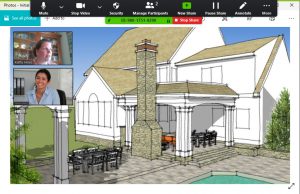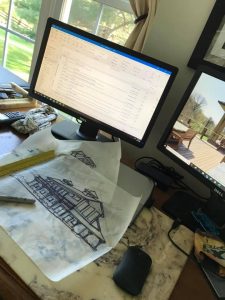Virtual Renovation Design: Challenging Times Encourage Us to Work Smarter
BOWA Has the Tools and Experience to Safely and Productively Collaborate with Clients Remotely Despite the Current Coronavirus Situation
The understatement of the day is this is certainly an interesting time for all of us. Between a declared coronavirus pandemic and the related economic uncertainty, we’re all still trying to figure out what this means for our families, communities, businesses and country.
Some might look at the current situation and shutdown in panic. While others might recognize that this too shall pass, and often, in times of adversity, we’ve discovered some of our greatest strengths and advances as people and a society. Medicines, cures, technologies and smarter ways to do things have all grown out of challenges like we’re currently facing.
That’s a lofty introduction, but even in the remodeling industry this applies in terms of virtual renovation design. Over the years, teams have developed a number of ways to improve and ease collaboration with clients. Many solutions evolved in response to clients’ demanding schedules but were only utilized as needed. However, the current coronavirus situation, has us rethinking. Perhaps these tools shouldn’t be a last resort. Perhaps they are keys to a smarter, more efficient way of working with clients that benefits everyone.
We will see what the future holds, but for now these tools can allow us to continue to work productively with prospective clients while being sensitive to the coronavirus situation and responding to the need for social distancing.
 Zoom and Other Online Meeting Tools
Zoom and Other Online Meeting Tools
Video-based meetings have become widely adopted as a way for remote parties to collaborate. With screensharing, easy access from wherever you are and no traffic to fight, Zoom meetings can be just as productive as in-person meetings and are a great way to keep project design and planning moving forward.
Preliminary Field Measures
For scenarios where a field measure by a member of your design team isn’t feasible there are options that enable the homeowner to provide the information the team needs to begin designing. One option involves pictures with a smartphone and another includes a special camera mounted to an iPad, which can be sent back and forth. The photos can be uploaded into a Computer-Aided Design (CAD) application, from which designers generate as-built drawings and 3D models of solutions for review with clients. The preliminary measurements aren’t precise enough to get all the way to construction but are within a margin of error that is appropriate for the schematic design stage.
Virtual Showroom Visits for Selections
Many vendors also offer the option to meet virtually with clients and designers. Using video meetings, product specialists can talk through options, needs and budget goals and pull physical samples from their showrooms to review online. You can mix and match in real time until you have one or more combinations you think will work. From there, the product specialist can send photos or physical samples for you to review in person.
Bublup, Houzz and Other Information Sharing Tools
Tools, such as Bublup and Houzz, allow parties to share photos and other documents for project planning. Bublup is an easy-to-use visual file system that lets you keep links in the same folders as PDFs, photos, videos, GIFs, notes, and other files. Houzz has over 20 million high-quality, home-related photos, that can be collected in idea books, commented on and shared. These are great ways for homeowners to organize their thoughts and convey their likes and dislikes.
With folks likely spending more time in their homes and having fewer outside demands on their schedules, now may be a great time to harness the power of these tools for virtual renovation design and planning. When the time is right, you’ll be several steps closer to your dream home!
Learn more about our low-risk method for renovation planning and budgeting.
OTHER POSTS

